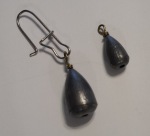See what happens when I get busy or distracted. I had been writing this post for the week of May 15-20 and I got distracted or sidetracked and now here it is almost Memorial week-end and I am just coming up for air. So here is the final thoughts on Wicked…
After the stitching is completed then the piece has to be finished. I know I have been showing how to finish needlepoint but last year I was not up to the task of finishing. That’s my story and I’m sticking to it…Seriously, I can do ornaments and some other little stuff but really haven’t had the time to try the biggies. One day I am going to try a pillow and a purse but for now I’m going to send big pieces to the finisher. I can’t even find time to sew a button on, let alone make a blouse or finish big needlepoint or for that matter any needlepoint.
I knew where I wanted to hang “Wicked” and how I wanted it finished. I drew a picture for the finisher and once the material was purchased I sent it to her to do her magic. I was very pleased with the way it was finished and I love to see it hanging at Halloween.
To some people finishing a piece of needlepoint is easy; they take it to a trusted shop and have it finished. Not me, I agonize over finishing. As I am stitching I can see the finished piece, I get these pre-conceived images in my head and then I feel like I need to look for the material to finish the project. Nice for me I know the finisher and I can as her if my idea will work. If she says yes, then I’m off to look for material.
Now, let me give you the advice I seldom ever follow but every finisher I know will tell you is the truth.
You should buy the fabric for finishing before you ever start stitching.
I know, seems illogical to me too, but remember we are limited by out thread choices and the fabrics we choose to finish our pieces are limited by their color choices. Now I will admit if you go to Hamilton Mo or any large quilt shop, you should be able to find a fabric. But what if you want a velvet or moiré for that Christmas stocking you are spending hours stitching? There is a world of difference between DMC 666 red and DMC 321 or 498 red. And fabrics only come in certain colors. And yes, you could use green for the backing and lining, but there are different greens too. So, if you want as perfect a match as you can get; sometimes it is important to buy that fabric first.
And while we are talking “you buy the fabric”; remember that if you want self-cording you need extra fabric. Self-cording is cut on the bias of the fabric and will require more fabric. Just as local needlepoint shop or finisher how much fabric you will need to finish your piece.
And some shops stock fabrics for finishing, so ask before you head all over the countryside looking for that perfect fabric. Some finishers have fabrics stockpiled and if you ask the shop you use, they probably can tell you which red would be best on that stocking or they can ask the finisher for you.
I’m lucky we have several very nice fabric shops in the area. Sarah’s in Lawrence (http://www.sarahsfabrics.com/), and several quilt shops in the area, plus Hamilton, Mo (https://www.missouriquiltco.com/). I’ve been to Hamilton twice now and while it is both eye candy for the imagination it can be overwhelming also. Hamilton is quilt town in northern Missouri, aka Missouri Quilt Co; Google it or read my post from last year…
A word about finishers… Have you ever wondered why so many shops guard their finisher’s name so closely? The real reason is that they are not trying to keep her a national secret, they are trying to protect her from the thousand calls she would get during busy times of the year asking, “Is my ornament finished yet?” And that is why finishing deadlines are so early. I think a finisher told me one time she finish over 1000 ornaments for Christmas and that didn’t count the stockings. Keep in mind blocking boards can only hold so much and sometimes pieces need to be blocked more than once and sometimes needlepoint even needs to be cleaned before blocking may begin. (This is another blog…but stitching in the hand vs stitching on a frame does have its drawbacks as well as its advantages…I will put this on my list of things to write about.)
Back to “Wicked”… I found the fabric and Batik at Hamilton and bought it. Brought it home and took it to the shop for my finisher to pick up (No, just because I know her doesn’t mean I don’t have to take it to the shop. My finisher will not accept pieces except through the shops she does finishing.) I took the piece about mid-May and I got it back about mid-August.
What took so long? Mine was not the only finishing in line. Mine had to be blocked, just like the rest and maybe twice I didn’t ask; and it’s a pretty big piece so it took up some real-estate on the blocking board. Mine also only had the green material supplied, so my finisher had to get the black for the inset, thread and even the interfacing. I could have purchased the black but I didn’t think about it at the time and she suggested this after she saw the piece…that’s another reason you use a finisher…She’s seen enough pieces to know what looks best even when you limit her by you pre-conceived finishing. And I had no idea what interfacing she would recommend. So see, Finishers do more than finish; they make your needlepoint look just like you want, and they know from experience what works best.
When “Wicked” returned home, it was just what I envisioned and more. I hung it and hated to see Halloween come to an end. I sometimes think I stitch long hours for a piece that only is displayed for a short time but I like it and it brings a smile to my face. And I hope it will be around for many years to come, maybe even one of my Grandchildren will want it when I am gone. Sometimes I get it out in it’s protective bag, and hand it on the door of my office just to look at it…it makes me smile.
Oh and before I forget; what do I do with the stitch guide after I complete stitching the canvas? I destroy it; it is a copyrighted piece of work. And in my opinion, stitch guides should not be bought or sold without the purchase of the canvas! I have done two or three stitch guides for canvases and I will not sell them to individuals only to shops where I assume the canvas is purchased.
I know a stitcher who saves her stitch guides as a reference and that’s fine but I don’t want all the extra paper. I might make a note in my computer or my stitch notebooks I keep about a technique, stitch pattern or stitch but my stitch guide goes to the trash. I do not share it with my stitch friend who bought the canvas only because she liked mine. I destroy it. Enough said…my soap box stand for the week.
On another note…my family is having a garage sale…no needlepoint but I do have needlepoint books I have accumulated over the years. I will list them here next week with cost and then I will put them on Needlepoint Nation Stash after that.
Thank you for stopping by, I hope you have time to stitch today and over the holiday week-end. AND please don’t forget to honor those you know who are serving or have served in our military. Without these brave men and women we would not enjoy the freedoms we take for granted.
ttfn…sue














































































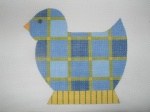


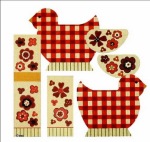





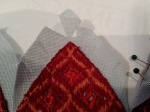
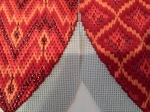

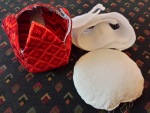

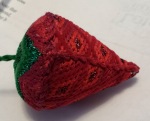






 as to be attached securely. I sometimes slip my needle back and re-stitch areas where the canvas has been left open and where the cording passes through itself and the knots are hidden.
as to be attached securely. I sometimes slip my needle back and re-stitch areas where the canvas has been left open and where the cording passes through itself and the knots are hidden.



 w it a ribbon down her back and I just love her basket and the bullions on her hat and shawl…not that I loved doing the bullions…I just like the way they look.
w it a ribbon down her back and I just love her basket and the bullions on her hat and shawl…not that I loved doing the bullions…I just like the way they look.



